You are seeing an unstyled version of this site. If this is because you are using an older web browser, we recommend that you upgrade to a modern, standards-compliant browser such as FireFox [http://www.getfirefox.com/], which is available free of charge for Windows, Mac and Linux.
Neo-Assyrian Texts from Dur-Katlimmu
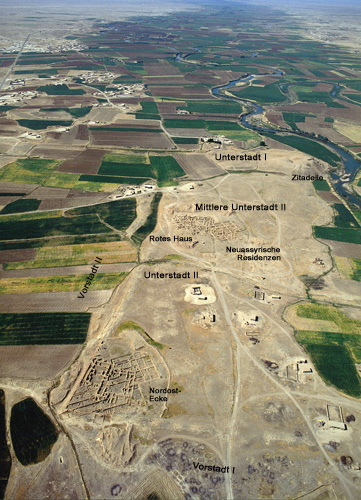
Aerial photograph of the site of Dur-Katlimmu and its extensive Lower Town. Photo credit: Georg Gerster, for the Tell Schech Hamad Project. [https://www.schechhamad.de]
Located on the eastern bank of the Khabur River in north-eastern Syria, the archaeological site of Tell Sheikh Hamad is one of the best explored cities of the Assyrian Empire. A German team led by Hartmut Kühne (Free University Berlin) explored the site [https://www.schechhamad.de/] in thirty-two excavation campaigns undertaken between 1978 and 2010, after the archaeological team mapping the Khabur valley's many sites in 1977 learned that local people had found a group of clay tablets in the course of constructing a water reservoir on the settlement mound of Tell Sheikh Hamad. These tablets turned out to be the remains of an administrative archive of the 13th and early 12th century BC that deals with the running of the agricultural estates supporting the Assyrian provincial government.
To the Assyrians, Tell Sheikh Hamad was the city of Dur-Katlimmu, a provincial centre of great prominence in the kingdom of Assyria since the 13th century BC. By the 7th century BC at the latest, the city was also known under the Aramaic name Magdala (URU.ma-ag-da-lu and Aramaic mgdl in BATSH 6 39 [/atae/durkatlimmu/P527164]), which means "Tower" and is a very common West Semitic toponym, attested as far away as on the Sea of Galilee [https://en.wikipedia.org/wiki/Magdala] and in the Nile Delta in Egypt (Jeremiah 44:1; Ezekiel 29:10; 30:6). Use of the secondary name Magdala for Dur-Katlimmu reflects the fact that at that time, Aramaic was the most commonly spoken language in the city, and more generally in the Assyrian Empire. While the name Dur-Katlimmu falls out of use after the collapse of the empire, the toponym Magdala is attested for Tell Sheikh Hamad until the third century AD, as shown by its mention in the texts from Dura-Europos and elsewhere from the Middle Euphrates.
Dur-Katlimmu lies on the eastern bank of the Khabur river in the "risk zone" between the Mediterranean climate zone and the steppe zone. A local irrigation canal system supported the rain-fed agriculture and allowed to bring in good harvests of barley, wheat and sesame, supplemented by vegetables and herbs while shepherds took the flocks of sheep and goats into the steppe: their wool and hair (for felt) was the backbone of the local textile industry.
Dur-Katlimmu was linked to the city of Assur through a direct overland route that during the imperial period of Assyrian history was part of the "King's Road" network (see BATSH 6 70 [/atae/durkatlimmu/P527195] and the essay "The King's Road" [https://www.ucl.ac.uk/sargon/essentials/governors/thekingsroad/] on the Assyrian Empire Builders site). Shalmaneser I [/riao/thekingdomofassyria13631115bc/shalmaneseri/index.html] (r. 1273–1244 BC) had founded a temple for the god Salmanu there, a deity closely associated with the Assyrian royal family and also celebrated by this king's name, which in Assyrian is rendered Salmanu-ašared "The god Salmanu is eminent." Salmanu's name means "the kind one" and perhaps he was merely a deified aspect of the god Aššur, whose intimate connection to the city of Assur made building other temples in his own name awkward.
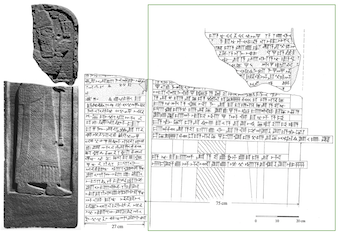
Two fragments of a rounded-topped Neo-Assyrian stele inscribed with Akkadian inscriptions of king Adad-nerari III and the local governor Nergal-ereš. Image created by Nathan Morello.
In the period of the re-conquest of the lost western regions in the 10th century BC, Dur-Katlimmu played as an Assyrian enclave a crucial strategic role. In the 9th century BC, a sizable fortified lower town was added to Dur-Katlimmu, transforming it from a relatively small town into a 60-hectare-large city with a fortification wall of almost 4 kilometers, traversed by a 9-meter-wide canal —modest when compared to contemporary Kalhu with its 360 hectares, but by far the biggest settlement on the Khabur. A fragmentary stele [/riao/theassyrianempire883745bc/adadnarariiii/texts121/index.html#adadnarari305] found in several parts at Tell Sheikh Hamad records how king Adad-nerari III [/riao/theassyrianempire883745bc/adadnarariiii/index.html] (r. 810–783 BC) and the local governor Nergal-ereš renovated the Salmanu temple, using cedar logs procured from Lebanon during a military campaign to the Mediterranean.
Much of the archaeological work since 1978 has focused on Dur-Katlimmu's lower town, unearthing several enormous mansions modelled on the palace architecture of the imperial centers in the Assyrian heartland. Several of these buildings yielded clay tablets. The best known of mansion, with by far the largest archive, is the so-called Red House (German "Rotes Haus"). It dates to the 7th century BC and is the residence of the wealthy landowner Šulmu-šarri, a contemporary and personal acquaintance of king Ashurbanipal [/rinap/rinap5/] (r. 668–ca. 631 BC). That Šulmu-šarri was an officer in the army is likely, as most people acting as his witnesses in the legal documents of his archive held military titles: Dur-Katlimmu housed a garrison, including a chariot corps and intelligence services. When Šulmu-šarri was at least 50 years of age, he was promoted to the distinguished position of a "friend" (ša qurbūte, literally "he who is close") of Ashurbanipal, which allowed him to represent the king in confidential matters all over the empire.
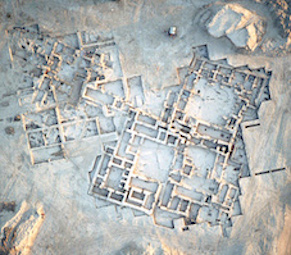
Aerial photograph of the Red House. Photo credit: Tell Schech Hamad Project. [https://www.schechhamad.de]
His large private archive consists of clay tablets inscribed in Assyrian cuneiform (ca. 150 texts) and Aramaic alphabet script (ca. 50 texts) and documents the business activities of Šulmu-šarri and his heirs, even during and after the disintegration of the Assyrian Empire. Like many who enjoyed the king's favor, Šulmu-šarri was a very rich man. The preserved purchase documents mention eight fields, three gardens and three houses and agricultural buildings in and around Dur-Katlimmu, and he also owned an entire village in the region of Aqra in northern Iraq, as we know from a court record dealing with a crime committed there (BATSH 6 71 [/atae/durkatlimmu/P527196]). We can be certain that he had additional estates beyond those mentioned in the documents, some perhaps granted by the king. The Red House is testament to his wealth. With a living space of 5400 m², this enormous building consists of three separate wings arranged around three paved courtyards. The main entrance in the north led into the first part of the building with ample storage facilities, some refrigerated. A central reception hall provided and regulated access to the representative wing in the east and the private quarters in the west of the building. There were two wells, several kitchen areas and four bathrooms, all connected to the complex sewage system. The building had a second floor, accessible by four staircases. Šulmu-šarri and his family shared this mansion with their many slaves. Within three decades, he bought more than fifty people. Two thirds were females, often mothers with young daughters, and the remains of horizontal looms along the walls of the courtyards of the Red House suggest that they contributed to the household's textile production. The shepherds in Šulmu-šarri's employ who grazed their flocks in the steppe east of Dur-Katlimmu provide the necessary wool for this work (BATSH 6 32, 110, and 123 [/atae/durkatlimmu/P527157,P527235,P527247]).
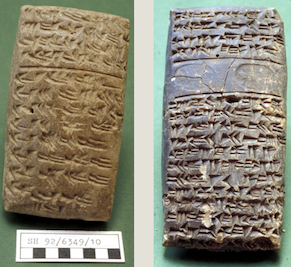
Two clay tablets from Room XX of the Red House dated to the reign the the Neo-Babylonian king Nebuchadnezzar II. Photo credit: Tell Schech Hamad Project. [https://www.schechhamad.de]
Three adult sons of Šulmu-šarri are attested in the family archive. We do not know anything about their mother but it is possible that she was a relative, perhaps a sister or daughter, of Šulmu-šarri's close associate Rahimi-il, an officer in the chariot corps. Such a family connection would explain why some of Rahimi-il's legal documents were found in the family archive. The sons inherited their father's estate after he died sometimes during the reign of Ashurbanipal's second successor Sin-šarru-iškun (r. ca. 626–612 BC), certainly of old age. His grave is not known. Although underground tombs are attested elsewhere in Dur-Katlimmu, no such structure was found at the Red House. Perhaps Šulmu-šarri was buried at another of his many estates.
The latest texts of the Red House archive illuminate the political situation in Dur-Katlimmu at the crucial time of the Empire's disintegration. At first, just after 612 BC, the population was loyal to the Assyrian crown but local power rested now in the hands of a "city lord" rather than the members of the previous city administration (BATSH 6 199 [/atae/durkatlimmu/P527324]). A decade later, the city accepted Babylonian sovereignty: four private legal documents that otherwise confirm entirely to the Assyrian traditions are dated according to the regnal years of Nebuchadnezzar II (r. 604–562 BC; BATSH 6 37–40 [/atae/durkatlimmu/P527162,P527163,P527164,P527165]). As the mention of his priest Salmanu-šangû-uṣur in two of these texts indicates (BATSH 6 37 and 39 [/atae/durkatlimmu/P527162,P527164]), the temple of the god Salmanu was still active at that time.
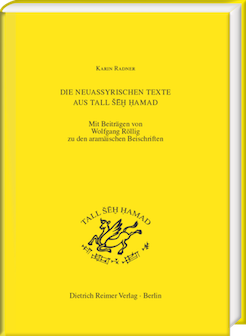
The Neo-Assyrian archival texts from Dur-Katlimmu/Magdala were published by Karen Radner, Die neuassyrischen Texte aus Tall Šēḫ Ḥamad. Mit Beiträgen von Wolfgang Röllig zu den aramäischen Beischriften (Berichte der Ausgrabung Tell Schech Hamad 6), Berlin, 2002 (which can be bought from Harrassowitz [https://www.harrassowitz-verlag.de/titel_1012.ahtml]); with further texts published in Karen Radner, "Neue neuassyrische Texte aus Dur-Katlimmu: Eine Schülertafel mit einer sumerisch-akkadische Königshymne und andere Keilschriftfunde aus den Jahren 2003–2009," [https://epub.ub.uni-muenchen.de/25003/] pp. 175–186 in H. Kühne (ed.), Dur-Katlimmu 2008 and Beyond (Studia Chaburensia 1), Wiesbaden, 2010. The Aramaic texts were published in Wolfgang Röllig, Die aramäischen Texte aus Tall Šēḫ Ḥamad / Dūr-Katlimmu / Magdalu (Berichte der Ausgrabung Tell Schech Hamad 17), Wiesbaden: Harrassowitz, 2014 (which can be purchased from Harrassowitz [https://www.harrassowitz-verlag.de/Die_aram%C3%A4ischen_Texte_aus_Tall_Seh_Hamad/Dur-Katlimmu/Magdalu/titel_90.ahtml]). The sealings on these tablets have been published by Anja Fügert, Die neuassyrische und spätbabylonische Glyptik aus Tall Šēḫ Ḥamad (Berichte der Ausgrabung Tell Schech Hamad 16), Wiesbaden, 2015 (which can be bought here [https://www.harrassowitz-verlag.de/titel_237.ahtml]).
An excellent source of information on Tell Sheikh Hamad and the excavations undertaken there is https://www.schechhamad.de/ [https://www.schechhamad.de/]. For discussions of Dur-Katlimmu and Duri-Aššur's archive, on which some of the sketch offered here is based, see: Karen Radner, Ancient Assyria: A Very Short Introduction, Oxford, 2015, pp. 38–44 and 55–57.
The editions presented on ATAE/Dur-Katlimmu have been adapted from the source publication from files kindly provided by Karen Radner. Please note that work on these texts is still in the early stages of preparation. As of January 2022, the Dur-Katlimmu corpus has not yet been fully lemmatized (linguistically annotated) or translated into English; the names have been linguistically tagged. Radner's original German translation, however, do accompany the partially-annotated transliterations. Please bear with us while we work on this material.
Click here [/atae/durkatlimmu/pager] to browse the Dur-Katlimmu corpus.
ATAE is a key component of the Archival Texts of the Middle East in Antiquity (ATMEA) sub-project of the LMU-Munich-based Munich Open-access Cuneiform Corpus Initiative [https://www.en.ag.geschichte.uni-muenchen.de/research/mocci/index.html] (MOCCI; directed by Karen Radner and Jamie Novotny). Funding for the ATAE corpus project has been provided by LMU Munich and the Alexander von Humboldt Foundation (through the establishment of the Alexander von Humboldt Chair for Ancient History of the Near and Middle East).
For further details, see the "About the project" [/atae/abouttheproject/index.html] page.

Karen Radner
Karen Radner, 'Neo-Assyrian Texts from Dur-Katlimmu', Neo-Assyrian Archival Texts from Dur-Katlimmu, The ATAE/Dur-Katlimmu Project, a sub-project of MOCCI, 2023 [http://oracc.org/atae/durkatlimmu/]